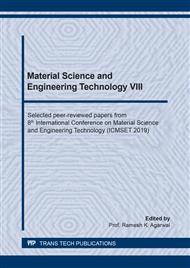p.170
p.179
p.185
p.191
p.197
p.203
p.209
p.215
p.221
Temperature Dependent Up-Conversion Luminescence Properties of Er3+ Doped KNN Ultrafine Powders Prepared by Pulsed Laser Ablation in Liquid
Abstract:
Er3+ doped potassium sodium niobate (KNN: Er) ultrafine powders have been prepared by pulsed laser ablation in water. X-ray diffraction (XRD) pattern of the sample demonstrated that the as-synthesized powders were crystalized in orthorhombic phase. Scanning electron microscopy (SEM) and transmittance electron microscopy (TEM) images exhibited that the morphology of ultrafine powders are cube-like. Under the excitation of 980 nm laser, the sample exhibits green emission, which is originated from the transition of thermal coupled energy levels (2H11/2, 4S3/2) to ground state level 4I15/2. Temperature dependent up-conversion emission intensity associated with thermal quenching of total green emission band and the fluorescence intensity ratio (FIR) between two sub-emission bands related to population of thermal coupled energy levels are investigated for temperature sensing in the temperature range of 300 K to 480 K. The temperature sensing performances related to different technique were discussed. A maximum relative sensitivity reaches 1.01% K-1 at 464 K for emission intensity thermometry and that is 0.84% K-1 at 374 K for FIR thermometry technique. All these results show that KNN: Er ultrafine phosphors prepared via pulsed laser ablation in water have prospect for non-contact temperature sensing.
Info:
Periodical:
Pages:
197-202
Citation:
Online since:
June 2020
Authors:
Price:
Сopyright:
© 2020 Trans Tech Publications Ltd. All Rights Reserved
Share:
Citation:


